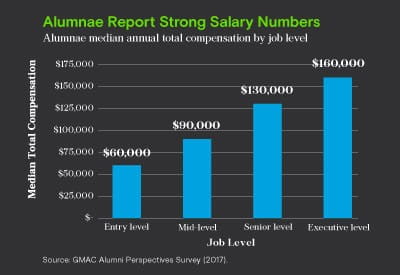Why More Women Are Applying to Business School

Trends in the areas of program options, candidate recruitment, and career outcomes that provide some insight as to why women around the world are deciding that now is the time to pursue a graduate management education.
Over the past several decades, women have made significant strides in narrowing the gender gap in applications to graduate business school. In 2016, women sat for 45.2 percent of the total number of GMAT® exams taken—the lowest female-to-male ratio in the history of the test (1.21). The most recent data from the National Center for Education Statistics show that women make up 47 percent of individuals receiving graduate business degrees from U.S. business schools, compared with 25 percent in 1980 and less than 5 percent in 1970.
Underlying these overall statistics are important trends in the areas of program options, candidate recruitment, and career outcomes that provide some insight as to why women around the world are deciding that now is the right time for them to pursue a graduate management education. Will you join them? Begin the journey to your graduate business degree by exploring what business schools can offer you by using the SchoolFinder tool.
Expanded program options
More than ever, business schools are offering a wider variety of program types and formats for women to choose from to find their best fit program. These expanded options include more non-MBA business master’s programs in specialized fields as well as new MBA program formats, such as the online MBA. For example, findings of the 2016 GMAC Application Trends Survey show nine percent of online programs are new in 2017. For many pragmatic applicants, these programs provide the flexibility they need to balance school, career, and family responsibilities.
Other growth areas include Master in Data Analytics programs (36% of programs are new in 2017), Master of Supply Chain Management (19% new in 2017), and Master of Marketing (16% are new in 2017).[1] These program types typically do not have the same professional experience requirement as MBA programs, providing new paths to a graduate business school education for younger, less experienced applicants.
Business schools are committed to enabling women’s success throughout school and their careers
Graduate business schools have worked diligently over the years to attract and recruit more women—particularly to MBA programs. In 2016, 68 percent of full-time two-year MBA, 50 percent of part-time MBA, and 46 percent of full-time one-year MBA programs reported making special recruitment efforts to increase the number of female applicants to their programs. Among non-MBA programs, most Master of Supply Chain Management (60%) and Master of Data Analytics (52%) programs also executed special recruitment efforts targeting women.
Over time, these initiatives have been successful in boosting awareness of the benefits of a graduate management education among women and growing the number of applications they submit. GMAC data shows that from 2011 to 2016, across all business school program types, the representation of women in applicant pools has increased.[2] And last year, a majority of full-time MBA programs globally received more applications from women than they did in 2015. Data from the Forte Foundation—a nonprofit organization devoted to promoting women’s access to business education and business careers—shows that women’s enrollment in MBA programs at 12 of its top US member business schools achieved a high of 40 percent in 2015.
This speaks to business schools’ commitment to providing their students—male and female alike—with an educational experience that prepares them for a rapidly changing job market. In 2015, at an event hosted by the White House Council on Women and Girls and the Council of Economic Advisors, 47 US business schools signed on to a set of best practices to help women succeed throughout school and their careers. This demonstrates how business schools are proactively taking steps to break down the unique barriers that women face in business careers and seeking to help the business community fully reap the benefits of a diverse workforce.
Business school alumnae’s positive outcomes
Any woman contemplating graduate management education can be assured that it is a smart investment in her future, in view of the highly successful outcomes female graduates report in the years since completing their degree. Among the nearly 4,000 women who participated in the GMAC Alumni Perspectives Survey fielded last fall, an overwhelming 95 percent of alumnae rate their graduate business degree as a good to outstanding value. Specifically, they view their graduate business degree as rewarding personally (97% of alumnae), professionally (95%), and financially (85%). Alumnae also agree that their business school experience provided them with substantial benefits and outcomes, including preparation for their chosen career (94% of alumnae), preparation for leadership positions (93%), increased earnings power (91%), and development of their professional networks (90%).[3]
In 2016, GMAC analysis of salary history for business school alumni shows that the median expected increase between pre-degree and post-degree salary is identical for both men and women, with a median USD$20,000 increase overall. This initial boost in post-degree salaries for men and women is similar across graduate business programs, including full-time MBAs, professional MBAs, and specialized master’s programs.[4] Although business school alumnae are not immune from the gender pay gap, they report strong median levels of total compensation across job levels.
Alumnae Report Strong Compensation Numbers

Are you ready to take your career to the next level with a graduate management education? Begin the journey to your graduate business degree by exploring what business schools can offer you by using the SchoolFinder tool.
[1] Graduate Management Admission Council. Application Trends Survey (2016).
[2] Ibid.
[3] Graduate Management Admission Council. Alumni Perspectives Survey (2017).
[4] Graduate Management Admission Council. Alumni Perspectives Survey (2016).



